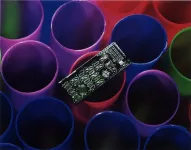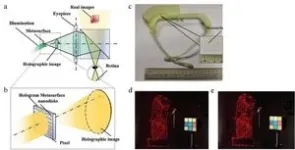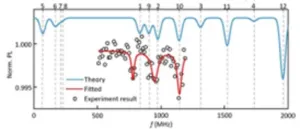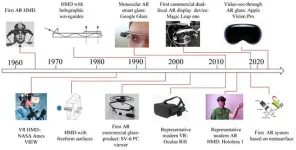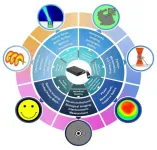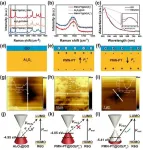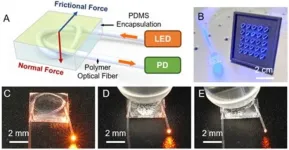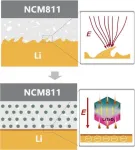(Press-News.org) Measuring the pH of substances gives us vital clues about the world around us, such as identifying contaminated water or checking the toxicity of medical or cosmetic products.
Often, only small amounts of samples are available, but monitoring the variation in pH in these miniscule volumes matters. For example, identifying pH changes within tiny volumes of fluid from single cells can help in the detection of ovarian cancer.
However, the current methods for measuring pH are mainly for bulk solutions and are not sensitive enough or are too fragile to measure small volumes on a commercial scale.
In a recent study published in Microchimica Acta, scientists from Xi'an Jiaotong-Liverpool University, China, have developed a method that overcomes these problems.
Dr Qiuchen Dong, who led the study, says: "Our solution needed to be environmentally friendly, durable, and sensitive enough to accurately measure pH variation in just a few microlitres of samples.
A lack of options
Some commercially available methods used to test pH rely on the subjective decisions of the human eye. For example, using paper strips containing dyes that change colour depending on the pH of the substance relies on people comparing the colour against a scale. This results in significant variation in their answers. Some people may view the colour as pH 7.5, others at 8, for example. This method, therefore, is not sensitive to small pH changes, meaning it's more like a rough guess. Some of the dyes used are also toxic to samples which will affect the pH recorded.
A more sensitive method of measuring pH uses extremely fragile glass electrodes, which are easily broken, so they are usually only used in a laboratory setting.
To solve these problems, Dr Dong and his postgraduate student Weiyu Xiao have used novel materials and methods to create a sensitive yet robust pH sensor.
A new solution
In Dr Dong and Xiao's new pH sensor, fluid samples run through a series of tiny channels (microfluidic channels) and over three highly sensitive electrodes made out of light-responsive layered materials and metals.
"Our solution to the problem relies on developing microfluidic channels and electrodes using photolithography, a method often used in the semiconductor manufacturing industry."
These microfluidic pH sensors can detect minor variations in the number of protons within a substance, which defines the pH. This allows the measurement of pH with excellent accuracy.
Future uses
The team currently has a patent pending for the pH sensor and is developing collaborations with industry developers who will integrate the technology into their lab equipment.
"The success of this study is down to the hard work of my current PhD student, Weiyu Xiao, who was a master's student during this work. It is very impressive to see a student reach such a high level in such a short period. She is a great role model, and I hope other students will be inspired by how much she has achieved.
"The work is also thanks to my previous colleagues, Dr Abdennour Abbas at the University of Minnesota and Dr Yu Lei from the University of Connecticut, who helped me to formulate the ideas for this project and many others."
The team believes that their new sensor will have extensive commercial applications, from aiding the detection of cancers and vector-borne viruses to identifying contamination in soil sprayed with pesticides.
About the researcher
Dr Qiuchen Dong's expertise lies in the topics of electrochemical-based biosensors, chemical sensors, and gas sensors in the aspects of design, fabrication, and evaluation for biomedical and agricultural applications from the year 2013 to 2021.
Professor Yu Lei supervised Dr Dong during his graduate studies in Biomedical Engineering at the University of Connecticut from 2013-2019. Afterwards, Dr Dong moved to Minneapolis to work as a Postdoctoral Research Associate in Professor Abdennour Abbas' lab in volatolomics in the Department of Bioproducts and Biosystems Engineering at the University of Minnesota, focusing on using Proton-transfer-reaction Mass Spectrometry (PTR-MS).
Dr Dong joined XJTLU in May 2021 and is now growing his lab to further explore various types of sensors, including microfluidics-based chemical sensors, nanomaterials-based electrochemical biosensors, and thin-film materials/nanoparticles/metal-organic-framework based gas sensors in the applications of biomedical and agricultural settings.
END
The little things matter: Chemists develop new sensor for microvolume pH detection
Researchers develop new environmentally friendly, durable pH sensor that is sensitive enough to accurately measure pH variation in just a few microliters of samples
2023-11-03
ELSE PRESS RELEASES FROM THIS DATE:
The USTC realizes In situ electron paramagnetic resonance spectroscopy using single nanodiamond sensors
2023-11-03
Teams led by Prof. DU Jiangfeng, Prof. SHI Fazhan and Prof. KONG Fei from the University of Science and Technology of China (USTC) of the Chinese Academy of Sciences (CAS) used the Nitrogen-Vacancy (NV) center inside a single nanodiamond for quantum sensing to overcome the problem of random particle rotation.
The study was published on Oct. 7th in Nature Communications.
It is an important goal to detect and analyze molecules under physiological in situ conditions in the field of life sciences. Only by observing biomolecules under this condition can we reveal conformation changes when they realize physiological functions.
Thanks to its high sensitivity, good biocompatibility, and ...
Men less likely than women to share negative information, says study
2023-11-03
A new study from Carnegie Mellon University, Bayes Business School (formerly Cass), and Bocconi University has found that men are less eager and likely to share negative information than women, while there was little difference when it comes to positive news.
Published in the Journal of Experimental Social Psychology, the authors suggest that this may be due to a greater concern among men over how other people will see them, resulting in a tendency to self-promote by sharing positive information about themselves and not revealing their negative experiences to others.
Dr Erin Carbone, Visiting Assistant Professor in the Department of Social ...
Focus on AR/VR: Near-eye display based on metasurface devices
2023-11-03
A new publication from Opto-Electronic Science; DOI 10.29026/oes.2023.230025 discusses near-eye display based on metasurface devices.
With the rise of the meta-universe, virtual reality (VR) and augmented reality (AR) technologies have been developing rapidly in recent years. Near-eye displays are crucial technologies for VR and AR. Despite the rapid advances in near-eye display technologies, there are still challenges such as large field of view (FOV), high resolution, high image quality, natural free 3D effect, and compact form factor. Great efforts have been devoted to striking a balance between visual performance and device compactness. ...
A review of liquid crystal spatial light modulators devices and applications
2023-11-03
A new publication from Opto-Electronic Science; DOI 10.29026/oes.2023.230026 overviews liquid crystal spatial light modulators devices and applications.
Technology to control and harness light has existed for centuries, often as static solutions that must be custom-designed. It is only in the past couple of decades that the digital era of micro-electronics and computing has seen fast rewritable technology meant for displays find its way into the mainstream of optics. In this review, the authors showcase the recent advances in replacing the traditional static optical toolkit with a modern digital toolkit for “light on demand”. ...
Ferroelectrically modulate the Fermi level of graphene oxide to enhance SERS response
2023-11-03
A new publication from Opto-Electronic Advances, 10.29026/oea.2023.230094 discusses Ferroelectric modulation of the Fermi level of graphene oxide to enhance SERS response.
Surface-enhanced Raman scattering (SERS) is a powerful fingerprint analysis and detection technique that plays an important role in the fields of food safety, environmental protection, bio-imaging and hazardous substance identification. Electromagnetic enhancement (EM) and chemical enhancement (CM) are the two recognized mechanisms of action for amplifying Raman signals. EM originates from the localized surface plasmonic resonance effect of noble metal nanostructures ...
Knot-inspired optical sensors for slip detection and friction measurement in dexterous robotic manipulation
2023-11-03
A new publication from Opto-Electronic Advances, 10.29026/oea.2023.230076 discusses knot-inspired optical sensors for slip detection and friction measurement in dexterous robotic manipulation.
Hands possess an awe-inspiring ability to perceive friction forces with remarkable accuracy, all thanks to the mechanical receptors nestled within skin. This natural gift allows objects to be handled deftly and tools to be wielded effortlessly, infusing daily life with a delightful flexibility. But what if this tactile prowess could be unlocked in robots?
Imagine a world where robots possess the uncanny ability to detect and understand friction and slip, just ...
Bridging the best of both electrolyte worlds for a better lithium-ion battery
2023-11-03
Lithium-ion batteries powered the device on which these words appear. From phones and laptops to electric vehicles, lithium-ion batteries are critical to the technology of the modern world — but they can also explode. Comprising negatively and positively charged electrodes and an electrolyte to transport ions across the divide, lithium-ion batteries are only as good as the limitations of their components. Liquid electrolytes are potentially volatile at high temperatures, and their efficiency can be limited by nonuniformity and instabilities in the other components.
Researchers are working toward developing safer, ...
Rafael De Cabo, Ph.D.(NIH), D.ing Xu, Ph.D. (UConn), and Claire K. Ankuda, MD, MPH, MSC (Mount Sinai Health System) to present lectures at AFAR Scientific Awards Ceremony
2023-11-03
November 3, 2023 -- The American Federation for Aging Research (AFAR), a national non-profit whose mission is to support and advance healthy aging through biomedical research, will host its annual Scientific Awards of Distinction lectures and ceremony on Friday, November 10 from 6:30pm-9:00pm ET in conjunction with the Annual Scientific Meeting of the Gerontological Society of America (GSA) held in Tampa, Florida. In addition to an awards presentation and reception, the honorees will present lectures highlighting their research.
Rafael de Cabo, PhD, will receive the 2023 Irving S. Wright ...
Study on Magnetic Force Microscopy wins 2023 Advances in Magnetism Award
2023-11-03
MELVILLE, N.Y., November 3, 2023 – An examination of the impact of image size on measurements from magnetic force microscopy has won the Advances in Magnetism Award, sponsored by AIP Advances, published by AIP Publishing.
The paper, “Finite image size effects on the characterization of magnetic domain patterns via magnetic force microscopy,” was selected as the winner from nearly 200 papers submitted as part of the 2022 Magnetism and Magnetic Materials conference. Michael Vaka, now a data engineer at Zontal, was awarded a cash prize and a travel stipend to next year’s ...
Press program now available for one of the world’s largest meetings in fluid dynamics
2023-11-03
The annual meeting for the American Physical Society’s (APS) Division of Fluid Dynamics will begin in two weeks with presentations on new research in aerodynamics, turbulence, wind and water power, bubbles, culinary fluid dynamics, medicine, and more. The conference will be held in person at the Walter E. Washington Convention Center in Washington, DC, Nov. 19-21.
There are no press conferences planned for this year’s program. However, a tip sheet highlighting newsworthy presentations is now available in the meeting’s press kit. Registered journalists ...
LAST 30 PRESS RELEASES:
Deep neural networks enable accurate pricing of American options under stochastic volatility
Collective risk resonance in Chinese stock sectors uncovered through higher-order network analysis
Does CPU impact systemic risk contributions of Chinese sectors? Evidence from mixed frequency methods with asymmetric tail long memory
General intelligence framework to predict virus adaptation based on a genome language model
Antibiotic resistance is ancient, ecological, and deeply connected to human activity, new review shows
Vapes, pouches, heated tobacco, shisha, cigarettes: nicotine in all forms is toxic to the heart and blood vessels
From powder to planet: University of Modena engineers forge a low-carbon future for advanced metal manufacturing
Super strain-resistant superconductors
Pre-school health programme does not improve children’s diet or physical activity, prompting call for policy changes, study finds
Autumn clock change linked to reduction in certain health conditions
AI images of doctors can exaggerate and reinforce existing stereotypes
Where medicine meets melody – how lullabies help babies and parents in intensive care
We may never be able to tell if AI becomes conscious, argues philosopher
AI video translation shows promise but humans still hold the edge
Deep ocean earthquakes drive Southern Ocean’s massive phytoplankton blooms, study finds
Without campus leftovers to pick through, the beaks of this bird changed shape during the pandemic
High-dose antibiotic does not reduce mortality in tuberculous meningitis
How many insects fly in the sky above the USA?
Could cheese protect your brain health?
Who faces more difficulty recovering from stroke?
Colliding galaxies create the brightest, fastest growing black holes at their center
New BrainHealth research reveals tradeoffs on sleep with cannabis use for chronic pain
Aging-US now on ResearchGate, enhancing visibility for authors and readers
'Molecular glue' stabilizes protein that inhibits development of non-small cell lung cancer
Mount Sinai Health System is recognized in 2025 Chime Digital Health Most Wired survey
From prey to predator: How carnivores spread beneficial fungi
Menopause symptoms may be frequent and have negative effects, according to female endurance athletes
US Congressmembers’ responses on X to mass shooting events differ along party lines
KAIST-UEL team develops “origami” airless wheel to explore lunar caves
Individual genetic differences render some therapies ineffective
[Press-News.org] The little things matter: Chemists develop new sensor for microvolume pH detectionResearchers develop new environmentally friendly, durable pH sensor that is sensitive enough to accurately measure pH variation in just a few microliters of samples
